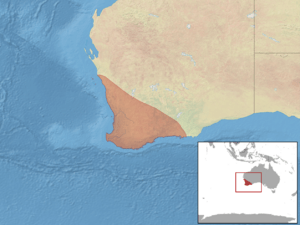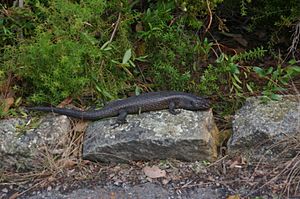King's skink facts for kids
Quick facts for kids King's skink |
|
|---|---|
 |
|
| Albany, Western Australia | |
| Conservation status | |
| Scientific classification | |
| Genus: |
Egernia
|
| Species: |
kingii
|
 |
|
| Synonyms | |
|
|
The King's skink (Egernia kingii) is a type of lizard known as a skink. It belongs to the Scincidae family. This special skink is only found in Australia, meaning it's endemic there.
Contents
What's in a Name? The King's Skink Story
The scientific name for this skink, kingii, honors an important Australian explorer. His name was Phillip Parker King. He was an officer in the Royal Navy and explored the coast of Australia a long time ago.
Where Do King's Skinks Live?
King's skinks live along the coast in the southwestern part of Australia. You can often find them on Rottnest Island and Penguin Island. They also live in some coastal areas that have open forests and open heathlands.
What Does a King's Skink Look Like?
The King's skink is a large and heavy lizard. It has a black body and can grow up to 55 centimeters (about 22 inches) long, including its tail. These skinks can weigh around 220 grams (about 7.8 ounces).
What Do King's Skinks Eat?
King's skinks are omnivores, which means they eat both plants and animals. They mostly munch on soft plants found in their local area. But they also like to add insects and birds' eggs to their diet for extra nutrition.
Who Eats the King's Skink?
Even though they are large, King's skinks can become food for other animals. One of their main predators is the tiger snake (Notechis species).
A Glimpse into History: The King's Skink
The local Nyungar people of southwest Western Australia have a traditional name for the King's skink: wandy. The first European to draw a King's skink was an artist and naturalist named Ferdinand Bauer. He made a very detailed drawing of one during Flinders' expedition in 1801.
Life Cycle and Reproduction
Like many skinks, King's skinks are viviparous. This means they give birth to live young instead of laying eggs. After being pregnant for about 20 to 22 weeks, a mother skink will have a litter of 2 to 8 babies. Each baby skink typically weighs around 7 grams (about 0.25 ounces). Many young skinks don't survive to adulthood, and it takes a long time for them to grow to their full size. Because of this, adult King's skinks can live for quite a long time!

See also
 In Spanish: Egernia kingii para niños
In Spanish: Egernia kingii para niños


